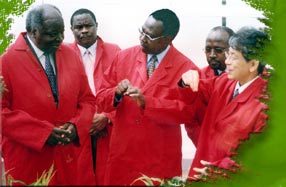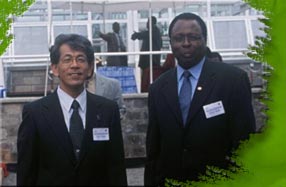August, 2004
 The official opening on 23 June 2004 of a level-two biosafety greenhouse in Nairobi, Kenya was marked by happy fanfare, but more importantly, a serious commitment from the highest levels to use biotechnology to help solve Africa’s pressing agricultural problems.
The official opening on 23 June 2004 of a level-two biosafety greenhouse in Nairobi, Kenya was marked by happy fanfare, but more importantly, a serious commitment from the highest levels to use biotechnology to help solve Africa’s pressing agricultural problems.
The biosafety greenhouse, constructed as part of the Insect Resistant Maize for Africa (IRMA) project, is the first of its kind in sub-Saharan Africa outside of South Africa. A biosafety greenhouse is very similar to a normal greenhouse except that it has special features to prevent the transfer of pollen, seed, and other plant material from transgenic plants to the outside environment.
The first order of business for the Kenya Agricultural Research Institute’s (KARI) new biosafety greenhouse will be the continued development of maize that resists stem borers and is environmentally friendly. This is the IRMA project’s primary objective. Stem borers typically inflict losses of about 15% annually to the Kenyan maize crop, and IRMA’s farmer surveys indicate that their control is a high priority for both small- and large-scale farmers.
 The President of Kenya, his Excellency the Hon. Mwai Kibaki, officially launched the facility. He was joined by Masa Iwanaga, CIMMYT’s Director General; Romano Kiome, Director of KARI; Andrew Bennett, Executive Director of the Syngenta Foundation for Sustainable Agriculture, which provided funds for the new facility; Shivaji Pandey, Director of CIMMYT’s African Livelihoods Program (ALP); and the Hon. Kipruto Arap Kirwa, Minister of Agriculture.
The President of Kenya, his Excellency the Hon. Mwai Kibaki, officially launched the facility. He was joined by Masa Iwanaga, CIMMYT’s Director General; Romano Kiome, Director of KARI; Andrew Bennett, Executive Director of the Syngenta Foundation for Sustainable Agriculture, which provided funds for the new facility; Shivaji Pandey, Director of CIMMYT’s African Livelihoods Program (ALP); and the Hon. Kipruto Arap Kirwa, Minister of Agriculture.
“We must embrace and apply modern science and technology in farming,” President Kibaki said. “Indeed, there is evidence that countries that have embraced modern agricultural technologies have improved economic performance, reduced poverty, and ensured greater food security for their people.”
“In embracing biotechnology, I am fully aware of the ongoing debate on biotechnology and its products, particularly genetically modified organisms,” President Kibaki added. “We in Kenya have resolved to apply biotechnology in line with the existing biosafety frameworks, national statutes, and international obligations. The newly constructed Biosafety Greenhouse Complex symbolizes that effort and will provide the internationally required containment for genetically modified material at the experimental stage. This will facilitate high-tech research in support of current and future agricultural endeavors.”
Speaking to more than 500 dignitaries, scientists, and representatives of farmers’ and civic organizations, CIMMYT Director General Iwanaga clearly laid out the case for using high science to meet the needs of resource-poor farmers. “What we now need, as with the first Green Revolution, is technology that is well-suited to the economic and physical circumstances of the region’s farmers and the political will to support development of that technology and create conditions conducive to its adoption,” says Iwanaga. “With this greenhouse opening and the training of competent staff to manage it, Kenya and KARI have positioned themselves to be leaders in sub-Saharan Africa in using the tools of biotechnology to meet the rapidly growing need to increase food production.”
In addition to constructing the biosafety greenhouse, the IRMA project is a pioneer in several other respects. To date, the project has focused on using Bt genes produced by the public sector and on using “clean genes” by removing antibiotic and herbicide resistant marker genes from the final products. Considerable effort has gone into collecting and characterizing the organisms typically found in maize fields in order to assess possible environmental impacts from the Bt maize. They have conducted extensive farmer and field surveys, which enable scientists to develop strategies that smallholders can employ to prevent the Bt resistance buildup by stem borers.
“We’ve set high goals for ourselves in terms of environmental safety, public awareness, farmer and stakeholder participation, developing human capacities where needed, and in developing effective products for farmers,” says IRMA coordinator Stephen Mugo. “It’s not often you see an international agriculture project moving forward successfully on so many fronts at one time.”

For more information: Dr. Stephen Mugo
 Climate adaptation and mitigation
Climate adaptation and mitigation 
